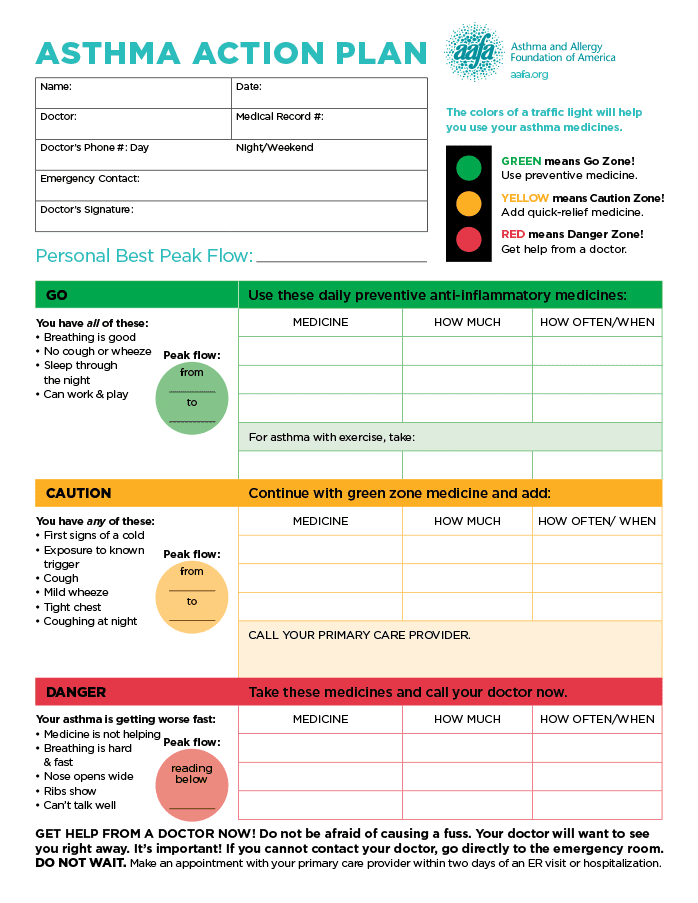Asthma
School Forms for Asthma
If your child has asthma or allergies, you will need to have forms on file with your child’s school for managing their condition, giving medicines, and handling emergencies. These forms are important to help keep your child healthy at school.
Depending on your school’s policies, these forms may be part of your child’s school health care plan. Or they may be used without a school health care plan. Either way, you will also need to fill out and submit a new set of signed forms each year.
During the summer before a new school year, get copies of these forms from your child’s school or district. Visit your child’s doctor to get these forms signed. It’s a good idea to schedule the appointment at least three to four weeks before the first day of school so the doctor’s office has enough time to sign them. Turn the forms in before the first day so the school has time to review them and prepare to handle possible symptoms and emergencies.
Your child’s school or district may require that you use their versions of these forms. If they don’t, your child’s doctor may have a standard form they use.

Medicine Authorization Form
If your child can self-carry and/or self-administer their asthma quick-relief medicine or epinephrine auto-injector at school, they will need a medicine authorization form.
These forms are required even if the school staff stores and gives the medicine. This form allows your child to have medicine in their belongings, and/or gives the school permission to give medicine to your child.
Self-carry and self-administration are two different decisions. For example, your child may be ready to carry their own medicine so they can have it close by in an emergency, but they may need an adult to help them take the medicine. Other children may be developmentally ready and prepared to take their own medicine. But during an emergency, they may need assistance. If the school form does not allow you and your doctor to make a choice between self-carry and self-administration, ask about changing the form to best suit your child’s needs. Every state has laws that allow your child to carry their own medicine.
Asthma Action Plan
Every student with asthma should have a written Asthma Action Plan. This plan gives information and instructions on how to manage asthma. It includes:
- Medicine instructions
- Recognizing when your child’s symptoms get worse
- What to do in an emergency
If your child does not have an Asthma Action Plan, ask their doctor for one. Give a copy to the school, their teachers, and other key staff. Include a photo of your child. Make sure your contact information is up to date.
If your child has asthma and food, latex, or insect allergies, they will need both an Asthma Action Plan and an Anaphylaxis Action Plan.
AAFA offers Asthma Action Plans in a few different formats that you can download, print, and use depending on your child’s needs and situation.
Asthma Action Plan (printable PDF)
An Asthma Action Plan has information and instructions on how to manage your asthma. It tells school staff and other caregivers about your child’s asthma. You can give it to teachers, school nurses, and afterschool care staff. (Available in English and Spanish)
Student Asthma Action Card (printable PDF)
The Student Asthma Action Card is great tool to give to your child’s school about asthma management. It has sections for asthma triggers, daily medicines, and emergency directions.
Child Care Asthma/Allergy Action Card (printable PDF)
This card has information you need to care for your young child with asthma or allergies. The card has sections for information about a medicine plan and a list of your child’s signs and symptoms. It also has steps on how to handle asthma and allergy emergencies.
Anaphylaxis Action Plan
If your child is allergic to certain foods, medicines, insects, or latex, they may be at risk for a severe allergic reaction (anaphylaxis). They need an Anaphylaxis Action Plan. This plan has information about your child’s allergy, what symptoms to watch for, and what to do in an emergency. It will also include important contact information.
If your child does not have an Anaphylaxis Action Plan, ask their doctor for one. Give a copy to the school, their teachers, and other key staff. Include a photo of your child. Make sure your contact information is up to date.
Special Dietary Meals Accommodation Form
You will need this form if your child has food allergies and will be eating meals provided by the school. Talk with the school nurse and the food services director about safe food choices for your child. See the U.S. Department of Agriculture (USDA) Accommodating Children with Disabilities in the School Meal Programs for more information. The USDA oversees school lunch programs.
Ask your child’s school or district for new forms each year. Then make an appointment with your child’s doctor to fill them out and sign them. Start this process in the spring or summer so you have plenty of time to get them on file with your child’s school before the first day.
Created August 2021

KFA is dedicated to saving lives and reducing the burden of food allergies through support, advocacy, education and research.














